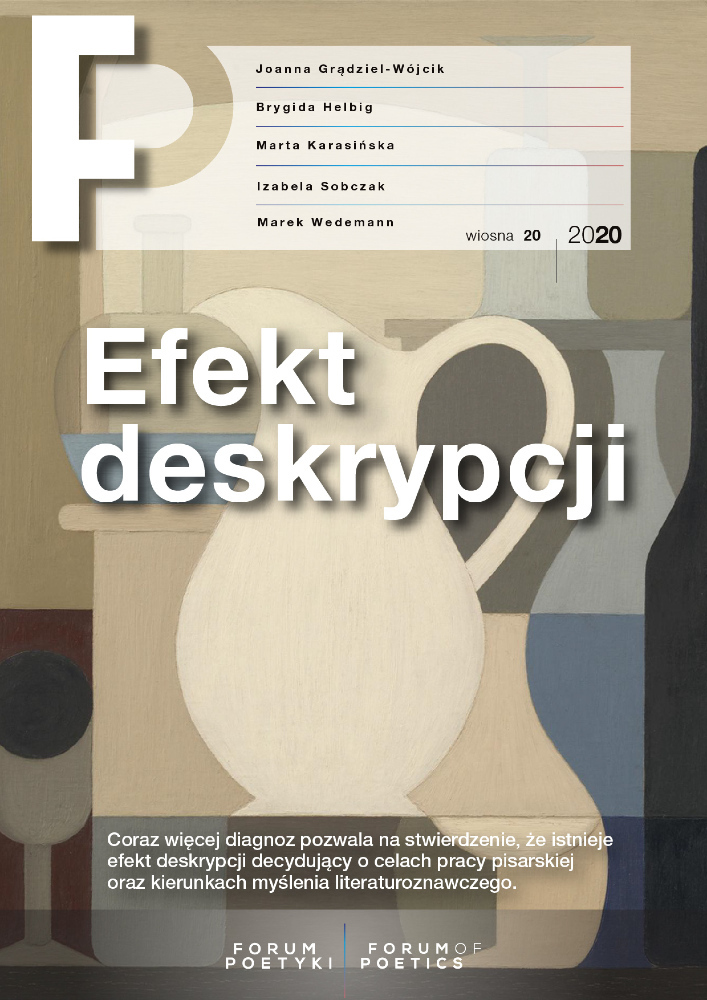No. 20 (2020)
The problem of description in a literary work of art and in other texts, explored more and more closely in recent years, appears to be an underestimated cause of change in literary studies. More and more studies allow us to conclude that there exists a description effect that determines the goals of writing and the directions of literary research. Description often affects the meaning of the work, its affective layer, stage and film productions, and the format of the books itself. It comes as no surprise that such a number of important, though usually diverse, problems continues to exert a strong influence on literary studies, where description appears in various forms as an effective verifier of research methods.
We present a panoramic view of the various interventions of description in contemporary literary studies, because one may notice the effectiveness of description and its continuous impact better from a certain distance. First, it should be emphasized that description raises a number of issues related to the “performance” of a work of art. Marta Karasińska discusses it in relation to dramatic works, whose goal seems to be to make the viewers reflect on description and discuss the transposition of descriptive sections into action but also to examine various ontologies of description. The relations between description and the form of the book are equally important, as evidenced by Katarzyna Krzak-Weiss and Bogdan Hojdis. They argue that the descriptive layer of text is often a key point of reference for the editor. The author and the editor engage in a dialogue, or even a dispute, about the most desirable method of illustrating the text and the editorial work for the described. The tasks of description in self-referential works seem to be extremely interesting. Agnieszka Waligóra discusses the role of description in Andrzej Sosnowski’s “deconstructionist” poems: description both evokes and quickly annihilates all forms of mimesis. In postmodern literary works, description was something that limited the possibilities of self-referentiality. Respectively, Joanna Grądziel-Wójcik emphasizes the essential values of description in women’s self-referential poems. She analyses numerous works by female poets which allows us to appreciate the role of descriptive passages, which often function as a pretext in the works of male poets. Brygida Helbig-Mischewski, an excellent Polish writer, would fully agree with such a line of reasoning. She comments on her own work in this issue. According to Helbig-Mischewski, description determines the affective dimension of her works and her personal styles of reading and interpreting literature in general. Thanks to description, she was able to develop self-reflective states, where reflection and knowledge had a different ontology than in the writings of many men who value adventure and plot. It turns out that description also has its gender genealogy that is worth reconstructing. All the more so because, as Marek Wedemann proves, Stanisław Przybyszewski in his works openly condemned descriptions, insofar as they did not concern the writer’s misogynistic antics. After all, description was used by Przybyszewski as a useful means of reaching reality, which brings us back to the initial remark on the effectiveness of description. Perhaps, therefore, description should be studied in a manner demonstrated by Izabela Sobczak. She discusses historical and contemporary roles played by description in case studies in many fields of science. It is perhaps only in such a context that we touch upon the complexity of the description effect.
Description is effective in a manner that we are still not able to grasp fully. Perhaps troubled book publishers best exemplify how description determines what can and cannot be done with a text. Therefore, more often than we have realized so far, it is description that determines and sets out the conditions for change in literary studies.
translated by Małgorzata Olsza
